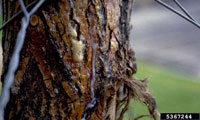Various bacteria species
Host
Elm, poplar, maple
Distribution and Disease Cycle

infection with bacterial wetwood.
Photo credit: William Jacobi, Colorado State University, Bugwood.org
Bacterial wetwood is a common disease affecting the trunk, branches and roots of many soft and hardwood tree species. While many common soil and water inhabiting bacteria are associated with wetwood disease, anaerobic bacteria are typically the primary cause. The bacteria are transferred by insects from infected to healthy trees where they become infected through wounds in the roots, stem or branches. While wetwood is usually not directly fatal to a tree, it may contribute to plant decline, especially in older trees, eventually leading to plant death.
Symptoms and Signs

Photo credit: William Jacobi, Colorado State University, Bugwood.org
The characteristic symptom of wetwood is bleeding of sap or "slime-fluxing" from trunk wounds or cracks. Air-borne pathogens often contaminate the sap, creating a flothy foul-smelling liquid that dries to a gray or white crust. Bacterial fermentation breaks down carbohydrates and other sap materials, producing abundant gas and pressure inside the tree, eventually forcing the liquid out of the trunk through breaks in the bark. The leaking sap prevents callus formation over wounds, increasing the susceptibility of infection by other pathogens, including decay fungi. This toxic sap may even kill the turf beneath infected tree. Foliage of infected branches may become chlorotic, scorched and wilt as large quantities of the liquid accumulate in the trunk.
Control
There is no known control for bacterial wetwood. To alleviate symptoms and lower stem pressures, a perforated pipe may be inserted into the trunk to relieve pressure and drain the liquid. Severely infected limbs should be removed in spring.